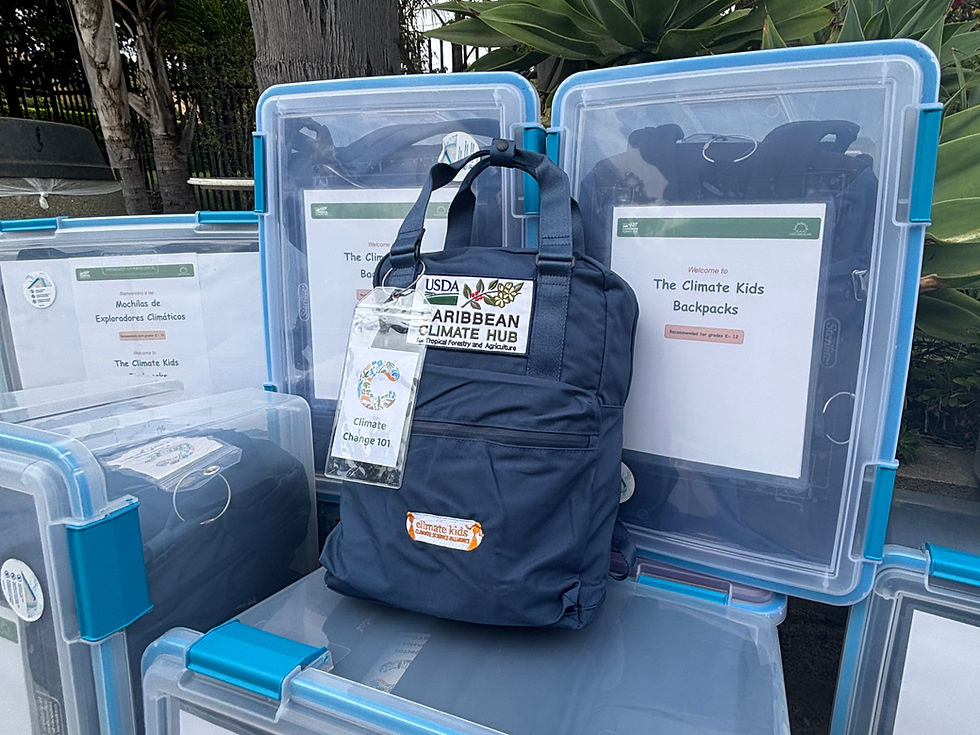Alliance Unveils New Atmospheric Chemistry Trunk with NSF CAICE Researchers
- Climate Kids HQ

- Oct 27, 2019
- 2 min read
The Climate Science Alliance was excited to help lead a training for NSF CAICE Researchers to utilize the NEW “Climate Science and Atmospheric Chemistry Traveling Trunk”. Starting Spring 2020, these researchers will use this educational resource at different CAICE research facilities across the nation to connect the public to this critical work.

Earlier this year, the Climate Science Alliance was excited to join forces with the interdisciplinary team of scientists at the NSF Center for Aerosol Impacts on Chemistry of the Environment (CAICE) to create materials to support community outreach on aerosols and climate change. The Climate Science Alliance worked alongside CAICE researchers to bring CAICE science to the Climate Kids program by developing a traveling trunk focused on Climate Change and Atmospheric Chemistry.

Climate Kids Traveling Trunks provide resources educators need to teach climate science, as it pertains to a certain topic. Each trunk includes background information, lesson plans, powerpoints, activities, and materials to increase climate literacy for K-12th grade youth. Climate Kids trunks feature interactive and hands on science, storytelling and art curriculum aligned to Next Generation Science Standards. The New Climate Change and Atmospheric Chemistry Trunk explores the complexity of aerosols and their interactions with climate change and public health.
This October, the Climate Science Alliance team unveiled the Traveling Trunk to CAICE researchers at their annual meeting. Climate Science Alliance staff provided a training on how to use the traveling trunk and incorporate the various components of hands-on science, art, and storytelling in their outreach activities. In the Spring this trunk will be available not only in San Diego for educators to utilize, but also at the other CAICE research locations across the U.S..

About CAICE: The NSF Center for Aerosol Impacts on Chemistry of the Environment (CAICE) focuses on improving our understanding of how aerosol particles impact the environment, air quality, and climate. Led by Dr. Kimberly Prather, UC San Diego Distinguished Chair in Atmospheric Chemistry, the Center’s goal is to understand critical details regarding the chemistry of aerosols.
CAICE tackles the grand challenge of elucidating how the chemical complexity of atmospheric aerosol particles impacts our atmosphere and climate. One important type of aerosol, sea spray, has tremendous chemical variability depending on ocean chemistry, biology, and physical factors such as waves and wind. CAICE has established a unique ocean-atmosphere interaction facility that replicates natural sea spray aerosol in a controlled setting, allowing for detailed fundamental studies of aerosol reactions.
CAICE has assembled an interdisciplinary team of scientists to accomplish this task: atmospheric, physical, biochemistry, analytical, and organic chemists, along with oceanographers and marine biologists. In addition to conducting innovative research, the CAICE team is dedicated to improving science education and impacting the public through outreach.
The Climate Science Alliance is excited to continue to build our strong partnership with CAICE to support their education and outreach efforts and unite Climate Kids programming with the topic of Atmospheric Chemistry and Aerosols.
To learn more about the NSF Center for Aerosol Impacts on Chemistry of the Environment (CAICE), please visit: www.caice.ucsd.edu











Comments